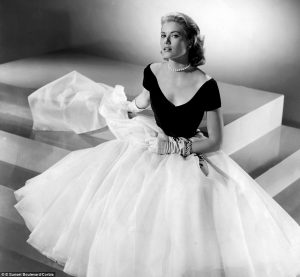I’m finally back with another blog post, this one of extreme interest to me. In class, we are currently discussing 20th century history, recently the 1960’s. So in this post, I’m looking into the life of Princess Grace Kelly, and how her marriage into the royal family of Monaco changed her career in an interesting manner.
We all look up to celebrities (don’t deny it), as they are the ones we watch on TV, hear about on the radio, and read about in every magazine. They are fascinating, entertaining, and secretly everything we want to be. For some, maybe it’s because you want to live in a mansion, or go to award shows every night, or travel around on a private plane, but for others, celebrities are like role models, in that their choices in life inspire us to leave our own legacies on people we impact in our lives.
Grace Kelly was born in Philadelphia on November 12, 1929. Her father, John Brendan Kelly, won three Olympic gold medals as part of the U.S. rowing team and owned one of the most successful brick businesses on the East Coast. Her mother, Margaret Katherine Majer, was the first coach of women’s athletic teams at the University of Pennsylvania. Regardless of her family’s sporty background, Grace expressed a passion for performance and the arts as a child, and participated in school and community plays and productions. She had a good introduction to the arts in her family as her two uncles both heavily influenced her; one a performer and the other a winning playwright.
Grace Kelly was a perfect candidate for the world of entertainment; She was gorgeous, talented, and humble. She had it all… except for her parents’ approval of her dreams. Her father was particularly unhappy with her decision to become an actress, and viewed the occupation to be “a slim cut above streetwalker”. Despite this disapproval from her family, Grace continuously built up her reputation as a hopeful actress beginning with her enrolment in the American Academy of Dramatic Arts, in New York City. After graduating from the Academy at age 19, Kelly looked for a career on Broadway, but found it difficult. Don Richardson, one of her directors and teachers, later said, “She would never have had a career in the theatre,” because she had “great looks and style, yes, but no vocal horsepower.”
Grace Kelly moved on to become a successful model and Academy Award winning actress. She starred in a large amount of films, many receiving high praise and some Academy Awards. Examples include:
Rear Window (1954) Alfred Hitchcock
The Country Girl (1954) George Seaton
To Catch a Thief (1955) Alfred Hitchcock
At this point in her career, Grace was one of the highest paid and most respected actresses in the world. In 1955, she was asked to join the United States Delegation Committee at the Cannes Film Festival in France. During a photo shoot there, she met Prince Rainier III of Monaco, who happened to be searching a wife at the time. If he didn’t produce an heir to the throne, Monaco would become part of France. Of course, they bonded and ended up engaged soon after meeting.
When she became a Princess, Grace Kelly’s acting career was virtually ended, and she could no longer follow her dreams. (This is a similar case to Meghan Markle, who just recently became the Duchess of Sussex. She has basically given up her life as an actress for princess hood.) She was also stripped of her American citizenship, and Prince Rainier banned her films from being played or shown in Monaco.
There were many attempts from Hollywood directors to bring Princess Grace back into the limelight of the film industry. Alfred Hitchcock offered Kelly the lead in his film Marnie in 1962. She was eager, but public outcry in Monaco against her involvement in a film where she would play a kleptomaniac made her reconsider and ultimately reject the project. During her marriage, Kelly was unable to continue her acting career. Though some believe she deeply missed her life as an actress, she often spoke of the many problems inside the film industry: “Hollywood amuses me. Holier-than-thou for the public and unholier-than-the-devil in reality.” Instead, she performed her daily duties as princess and became involved in philanthropic work.
She founded AMADE Mondiale, a Monaco-based non-profit organization that was eventually recognized by the UN as a Non-Governmental organization. It promoted and protected the “moral and physical integrity” and “spiritual well-being of children throughout the world, without distinction of race, nationality or religion and in a spirit of complete political independence.” Grace was also driven to improve arts institutions throughout Monaco, forming the Princess Grace Foundation in 1964 to support local artisans and dreamers. The Princess Grace Foundation-USA was created, after her death, to continue the work she had done throughout her life; assisting emerging theatre, dance and film artists in America. Grace Kelly was one of the first celebrities to support and speak on behalf of La Leche League, an organization that advocates breastfeeding. She also planned yearly Christmas parties for local orphanages and orphaned children.
Grace Kelly was not a shadow of Hollywood, nor was she remotely selfish or ignorant of the problems taking place around her. She was aware, kind, and willing to help the world. At the time of her death, Kelly and one of her daughters, Princess Stéphanie, were in a car when Grace suffered a stroke and steered them both off of the road. Both women were rushed to the hospital on September 13, 1982, where Princess Grace spent 24 hours in a coma before being taken off life support by her husband, at the age of 52. This was a tragedy, not simply for her family, or even Monaco, but for the world. They had lost a shining star, on and off the screen.
Princess Grace remains an admired figure to this day, as she was an example of the actress, princess, and good samaritan all in one. She is what so many young people aspire to achieve, as she truly followed her dreams and got to high places in life. Grace set a high bar for success, and inspires the successful modern woman. Though most of us can only dream of the success she achieved in her career, she has taught women of this era a many thing. Grace was determined to make it on her own, without the help of her family’s wealth or approval (so fight for your dreams ladies!). We can take away her art of negotiation and direction, as she used to direct her own contracts and arguments with companies like MGM, at a time when the studio was the BOSS. And finally, she showed us that it pays to be kind, graceful, and empathetic, because look what came about when she was. I’m not saying that we will all become actresses then princesses, but by using Grace as a distant role model, we can go through life impacting people in positive ways, leaving our own legacy.













